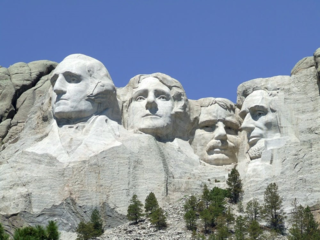Sport and Competition
The Decline of the American Hero
What public figures do people today admire, and why do they admire them?
Posted July 22, 2019

In one of my college classes, I used to ask the students to write down the names of three people who were their “heroes” and then to reflect on why they had chosen those particular people.
Only some of the respondents were able to come up with three names for their list. Many included only people from their families, perhaps a mother or father or older sibling. Sometimes, they identified a loved one who was dealing forthrightly with a severe mental or physical challenge.
As one might expect, the lists had many “public” figures, names the rest of us, or at least the members of their generation, would recognize. Of these, sports stars, actors, and musicians were predominant. Significantly, important politicians, business executives, or military figures rarely appeared.
Instead, people listed leaders of social movements, non-establishment figures like Martin Luther King Jr. or Cesar Chavez. Pointedly, the students considered such people and their ideals to be of continuing pertinence to their generation. Entirely absent from the lists were great figures from the “distant” past, that is, more than 50 years ago.
The students also noted people, or categories of people, whose names they did not know. There were “those firemen from 9/11” or “that captain who landed his plane in the Potomac.”
I should acknowledge that both male and female students tended to list the names of male heroes, not surprising in a culture that gives prominence to that sex. That having been said, many female students did list inspiring women. In contrast, rarely did a male list a woman who was not a family member. In much the same way, minority students might list prominent people from their social category, especially those who represented that group well or were fighting for its rights.
Predictably enough, the names of sports and entertainment figures shifted dramatically throughout the years. Michael Jordan gave way to LeBron James. Mia Hamm surrendered to Alex Morgan. Favored musicians and actors seemed even more fluid. What remained consistent, however, was that the students did not admire people younger than themselves. Instead, they preferred their idols to be a few years older, at the height of their powers, and thus providing a model of the fully realized life.
None of this, the reader would say, is especially surprising. However, it is worth noting that American practices of hero-identification have changed through the years. At least that is the argument of a great American historian, Daniel Boorstin, in his 1961 book, The Image: A Guide to Pseudo-Events in America.
As Boorstin saw it, 20th-century Americans viewed heroism differently than citizens of the 18th and 19th centuries did. In earlier times, news of public events traveled slowly. For that reason, heroes typically rose slowly in public consciousness, over months or even years. Once those heroes became widely known, they tended to maintain their high level of regard. People knew of them primarily through printed media or word of mouth. What they looked like, if this was known at all, was much less important than their deeds.
Most importantly, heroes were understood to be those who had contributed to the public good, sometimes at the cost of their own lives. For that reason, political and military figures might occupy those high stations. So might scientists, explorers, educators, writers, and religious leaders. In any case, heroism equated to profound societal contribution, commonly marked by difficulty or danger.
How were the 20th-century people different? By that time, people got their “news” (for this was the term) quickly through media sources like newspapers, magazines, radio, and television. Movies, including movie newsreels, were popular. So were phonographs. All this allowed people much closer contact with the activities of prominent people, not only as a recording of their day-to-day doings but also their physical images and even their voices. Distant figures became familiar. In some cases, people felt they knew their favorite TV stars better than they did their neighbors down the street.
Different also was the sense that people became prominent through public support. The more the population attended sports events and movies, read magazine or newspaper accounts, or otherwise gave attention to the person in question, the bigger those events and their stars became. Because of that, notable people became attentive to their images, the outward (and strategically crafted) manifestation of who they are.
For their part of the bargain, the population sensed that they had a newfound ability to create or, alternately, destroy their idols simply by offering or withholding support. Such, as Boorstin saw it, was one consequence of the democratic society: a place where ordinary people vote, not only for their governors but also for their “leaders” in other realms.
Most important of all was a shift in the criteria used to determine social importance. Admired now, or so it seemed, was success, and especially career success, in any field of one’s choosing. The sports star, leading actor, comedian, pop singer, or television evangelist received greater attention than the behind-the-scenes heads of less glamorous institutions. Publications trumpeted attendance figures and salaries.
Boorstin calls this transition the shift from heroism to celebrity. People became famous not for good deeds but for their high status in fields of public entertainment. Put most simply, they became famous for being famous.
Would anyone claim that the 21st century has reversed or even softened this change? The age of interlinked computers and satellite television means that people now receive worldwide exposure. Bombers, drug lords, and porn stars jump onto the stage of history, flicker briefly, and vanish. Institutional leaders become famous not for their years of hard work but for their moral indiscretions. Not everyone, but perhaps anyone, can become famous for a few minutes, as long as his or her behavior is curious enough and captured on camera. All that is required is a clever publicist, aggressive lawyer, or garrulous newscaster.
Boorstin’s general thesis is that the world is now flooded with “pseudo-events.” These are occurrences staged primarily for the sake of their being attended, recorded, and discussed. Think of movies, television shows, musical productions, sports events, press conferences, award ceremonies, openings of stores, and all manner of commercial messaging. Add to that all the goings-on found at websites and social media venues. Happenings there would not exist without their audiences. The larger those audiences, the more important those occasions become.
Again, why do we care about such things? Pseudo-events fill the world with news; they create excitement, they provide rhythm to our lives. As consumers, we enjoy the idea that these happenings are created to stimulate and amuse us. For many of us, a day without activities of this sort (“Did you see last night’s game?”) would be insufferable.
Most of us would respond that we are clear enough that a sports event, game show, or reality-TV drama is not an entirely “real” or “natural” affair. We know these are staged presentations. However, Boorstin argues that the omnipresence of these events is causing us to lose our sense of what is important in our lives.
Artificial enjoyments now take up a good portion of our imagining. We coordinate our own schedules with those of the event-makers. Their challenges and characters fascinate us: “What if I could become a professional athlete, movie actor, celebrity chef, rock star, top model, or professional video-gamer? Wouldn’t that be grand?” At any rate, these are the people whose posters we hang on the wall.
Let us return to my students, that younger generation whose development seems crucial to our social welfare. Most of them recognized that their idols were not quite heroes in the traditional meaning of that term. (That, after all, is the reason they nominated their own loved ones for that honor.) They acknowledged that some idols are purely celebrities and nothing more. Consider Paris Hilton or later, the Kardashians. However, they also confessed, honestly enough, that the model provided by such public figures—rich, popular, young, good-looking, sexy, well-traveled, and seemingly unfettered in every other way—was appealing. Wealth, prestige, and power (who cares today about knowledge) are pleasant poisons, delicious in their combination.
Interestingly, the students also introduced a third concept, the “role model,” which stands between the two previous categories. Role models are those who provide realistic goals for our own lives. Role models are aware that other people look up to them and, because of that, take seriously their responsibilities to them.
Adults can be role models without reaching the exalted status of heroes. Although we envy the wealth and popularity of the famous athlete or movie star, they are not role models unless they behave themselves in ways that fulfill their responsibilities to those not so favored. On-screen or on-court behavior is not enough. When they make significant contributions to disadvantaged people, perhaps through foundations or benefits, they enter the venues of heroism.
Be clear about another point. Contemporary people seem to have their own, or “personal,” idols. That is to say, my favorite rock star, actor, or basketball player is typically different from yours. More complexly, I may orient to a star performer in a field of endeavor—perhaps skateboarding, hip-hop music, or professional poker—that you know nothing about. People’s heroes, or so it seems, are meant to represent their own distinctive circle of commitments. That is why they rarely list politicians, soldiers, and business leaders, and why they do include family members (whom no one else in the room would know).
In Boorstin’s view, there were earlier generations of Americans who shared a registry of national heroes. They learned of the contributions of these seminal figures in school. They observed their countenance on money and stamps. They pondered their lives on designated holidays. There was some sense that these people—explorers, soldiers, politicians, scientists, business people, educators, and the like—had contributed in an exemplary way to nation-building. That appeal to nationhood was set above social allegiances of family, class, ethnicity, and region. Those leaders could call us, even from their graves, to sacrifice ourselves in public service.
People today know that many of those ancestral figures were flawed, sometimes profoundly. They might be racist, sexist, homophobic, and xenophobic. Some were slave-owners. Some brutalized the people they commanded or otherwise were insensitive to human suffering. Some sought fame as much as public contribution.
We also know that the “canon” of heroes was overly narrow, a celebration of the contributions of prominent people from certain categories (typically socially advantaged men of Northern European ancestry). Today’s Americans understand that people of diverse circumstances built the country we live in. More than that, we have become suspicious of leaders and their claims. It seems their visions embrace only certain people (essentially, those that vote for them) and that they enjoy too much their positions of authority.
Like my students, most of us have grown accustomed to a fragmented, if not openly partisan, America. That is why we reveal our political enthusiasms primarily to people we know and trust. That is why we maintain our own guarded registries of the other public figures we admire.
Nevertheless, there is something sad about this declination of support for broadly American heroes. To be sure, those people (commonly long dead) care nothing for such acts of remembrance. Instead, what is at stake is our own pondering of the ideals that guide us as a people. That commitment should extend across the social divisions so prominent today. It should keep alive the concept of a public good that transcends our selfish trajectories. It should reanimate the spirit of public responsibility as an important feature of the American tradition.
Surely, it is right that we have our own listings of the people we admire. But let us also honor those who contribute to the welfare of the millions seemingly not like us and who call us to become more expansive, compassionate versions of ourselves.




